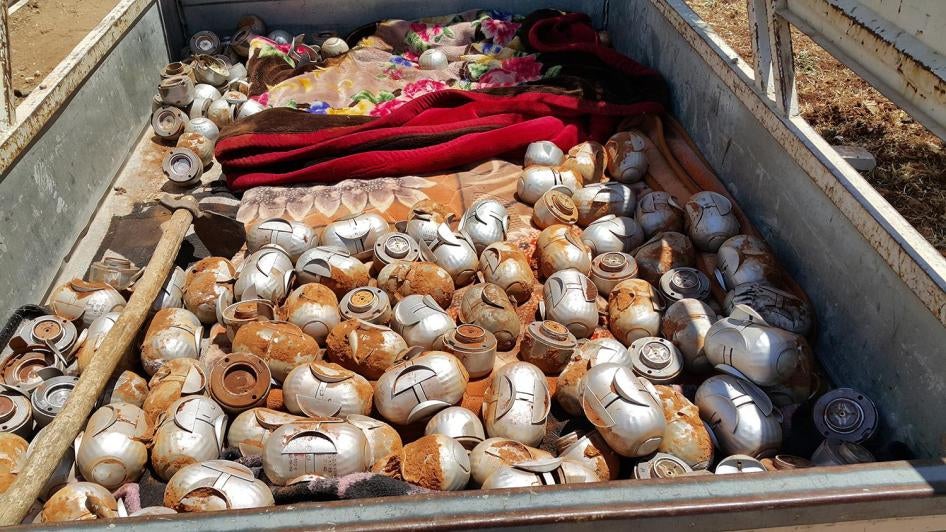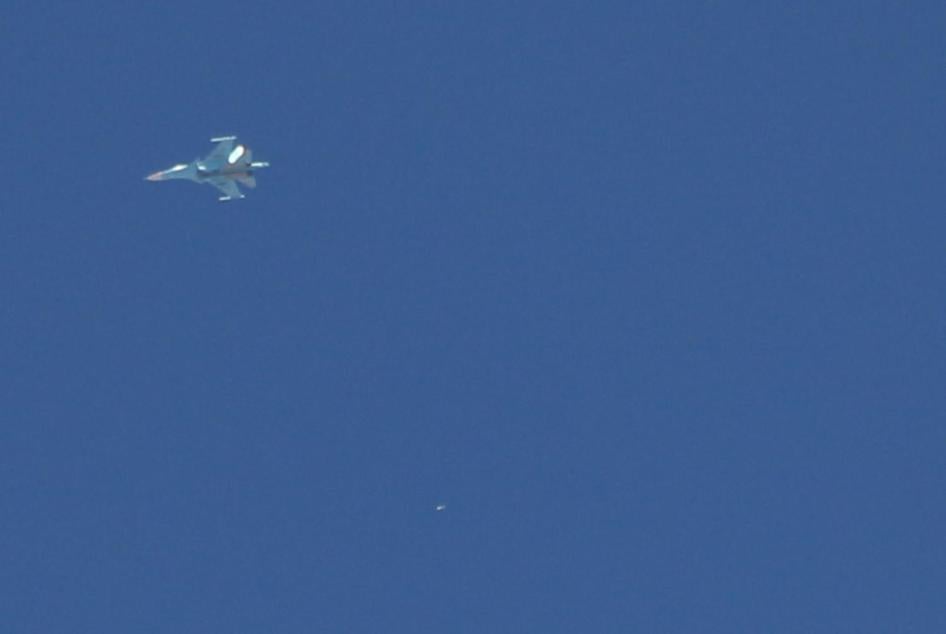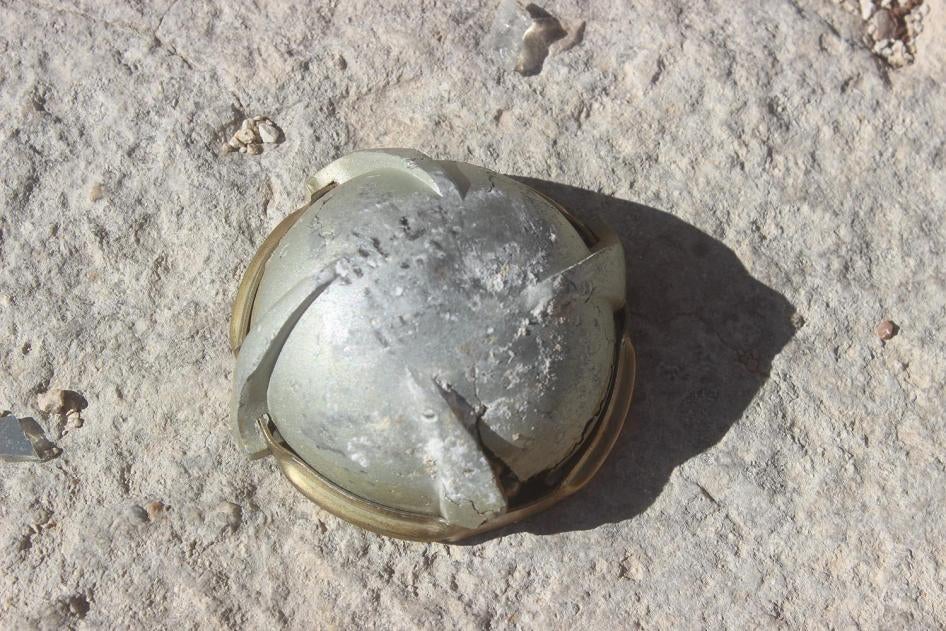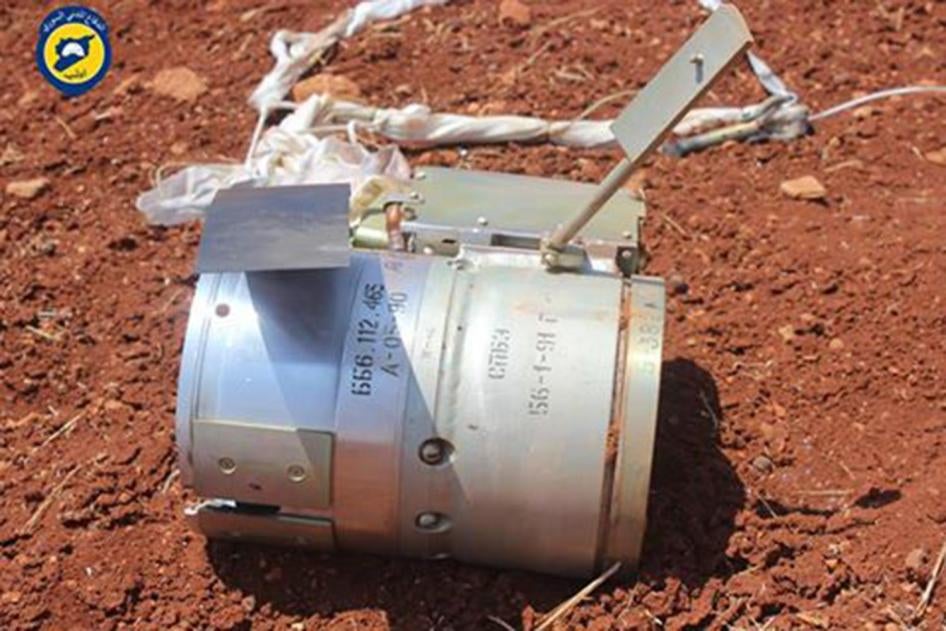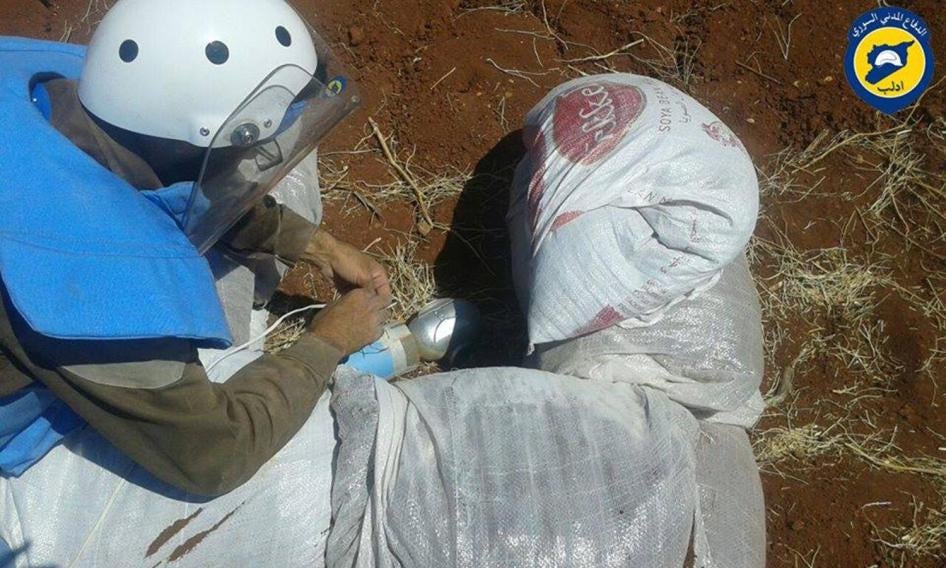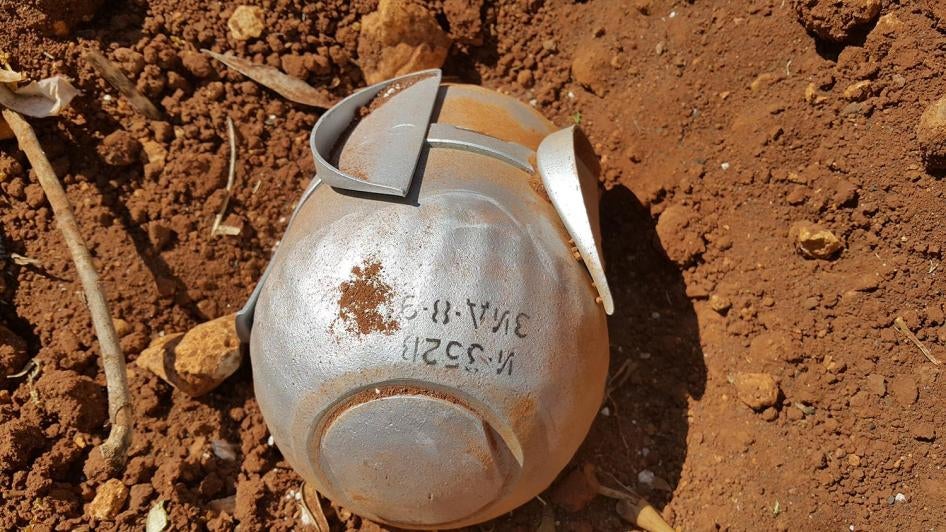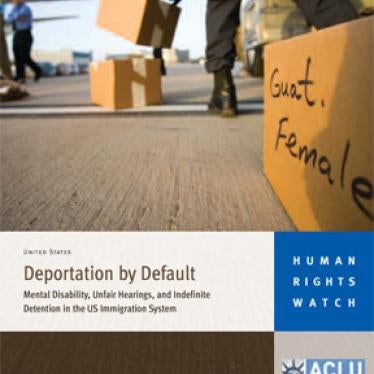(New York) – The Syrian-Russian joint military operation in Syria has extensively used internationally banned cluster munitions in its recent offensive, Human Rights Watch said today.
Human Rights Watch has documented 47 cluster munition attacks which killed and injured dozens of civilians in opposition-controlled territory across three governorates since May 27, 2016. The actual number of cluster munition attacks is most likely higher.
“Since Russia and Syria have renewed their joint air operations, we have seen a relentless use of cluster munitions,” said Ole Solvang, deputy emergencies director at Human Rights Watch. “The Russian government should immediately ensure that neither its forces nor Syria’s use this inherently indiscriminate weapon.”
A large number of the documented cluster munition attacks took place north and west of the city of Aleppo, as Russian and Syrian forces tried to besiege the part of the city controlled by armed opposition groups.
Documented Cluster Munition Attacks in Syria, May 27-July 25, 2016
Cluster munition attacks in Syria May 27-July 25, 2016 for which Human Rights Watch was able to identify information on the approximate location in relation to the nearest populated area and time of attack as well as visually confirm the type of cluster munition used.
[red dot] RBK-500 (AO-2.5RT/RTM), [yellow dot] RBK-500 (ShOAB-0.5), [white dot] RBK-500 (PTAB-1M), [green dot] RBK-500 (SPBE), [blue dot] 9M27K (9N210/9N235), [turquoise dot] M42/M46/M77-type DPICM
Although Russia has denied using cluster munitions in Syria, there is growing evidence that it has stockpiled cluster munitions, and has used or has directly participated in attacks with the weapon.
On July 11, at least three aircraft carried out multiple attacks on fuel trucks on the outskirts of Termanin, a village in Idlib province, killing at least 10 people, including a child, three first responders, and a local journalist, and wounding more than 30. The attacks involved cluster munitions and other weapons. According to nine local residents Human Rights Watch interviewed, all the victims were civilians.
While fuel supplies can be a legitimate target if used for military purposes, residents told Human Rights Watch that the area was considered a market for buying and selling fuel and that many civilians bought fuel there. The presence of civilians, the use of cluster munitions, which are inherently indiscriminate, and repeated strikes on the target even after first responders arrived make the attack unlawful, Human Rights Watch said.
Two witnesses said that at least three aircraft carried out the Termanin attacks. One witness identified the aircraft as two SU-34 and one SU-24 fighter-ground-attack jets. Russia is the only country that operates SU-34s. Human Rights Watch has also reviewed video footage of an SU-34 flying in the sky and a photograph of an SU-34 dropping a bomb, both taken near the attack site at the time of the attack. Several Russian online news websites that focus on military developments also reported that Russian aircraft carried out the July 11 attacks, citing unnamed Syrian military sources. Human Rights Watch has not been able to establish whether the SU-24 was operated by Russian or Syrian forces, and which type of aircraft dropped the cluster munitions.
In another case, aircraft attacked US-backed armed opposition forces near the al-Tanf border crossing with Iraq on June 16. Photographs posted on Twitter on June 19 by the forces that were attacked show cluster munition remnants, including unexploded bomblets, or submunitions. The US Defense Department claimed that Russian forces carried out the attacks. In a statement on its website, the Russian Defense Ministry appeared to acknowledge responsibility for the attack, saying that its forces had “operated within the agreed procedures and forewarned member states of the US-led coalition” about the strike.
Human Rights Watch has previously documented Russian aircraft flying near sites attacked with cluster munitions at around the time of the attack. In addition, the Conflict Intelligence Team open-source research organization has identified cluster munitions in photographs and video that Russian media and the Russian Defense Ministry took at Russia’s Hmeymim airbase in Syria after Russia began its air campaign in Syria in September 2015.
Cluster munitions are delivered from the ground by artillery and rockets, or dropped from aircraft and contain multiple smaller submunitions. The extensive use of cluster munitions in Syria poses a threat to civilians, not just because they are inherently indiscriminate weapons, but also because their submunitions often fail to explode and threaten civilians and military personnel alike until they are cleared and destroyed. Human Rights Watch has documented the use of 13 types of cluster munitions in Syria.
Since mid-2012, Syrian government forces have used both air-dropped and ground-launched cluster munitions. Cluster munition attacks in Syria have increased significantly since Russia began its military operation on September 30, 2015. Human Rights Watch previously documented at least 34 cluster munition attacks by the Russian-Syrian joint operation from that date through to February 8. The Syrian Network for Human Rights has documented 54 cluster munition attacks in Syria from September 30, 2015, to February 27, 2016. The number of recorded cluster munition attacks in Syria decreased in March and April, but increased again in late May.
The Syrian Archive, a platform that collects, curates and verifies visual evidence of human rights violations has collected and analyzed hundreds of videos related to cluster munition attacks in Syria since the beginning of the war.
From March 29 to June 2, two trained teams from Syria Civil Defense, a search-and-rescue volunteer group that operates in opposition-held areas, cleared 615 submunitions in the provinces of Idlib and Hama alone, a reflection of the high failure rate of some of the cluster munitions used in Syria. The group had to suspend the work because of lack of necessary equipment.
A total of 119 countries have banned cluster munitions. Although Russia and Syria are not members of the Convention on Cluster Munitions, they are still bound by international humanitarian law, or the laws of war, which prohibits indiscriminate attacks. Syria and Russia should immediately stop using cluster munitions and join the Convention on Cluster Munitions. The civilian harm caused by the use of cluster munitions in Syria since 2012 has attracted public outcry and widespread media coverage, and has been condemned by more than 140 countries.
There has been no evidence to indicate that the US or its coalition partners have used cluster munitions in their action against Islamic State (also known as ISIS) forces in Syria and Iraq. Syrian government forces have used cluster munitions across the country since mid-2012, while ISIS forces used cluster munition rockets in northern Syria in the second half of 2014.
Human Rights Watch is a co-founder of the Cluster Munition Coalition, the international coalition of groups working to eradicate cluster munitions, and serves as its chair. On October 1, 2015, the global campaign warned Russia against using any cluster munitions in Syria due to the “foreseeable and preventable” danger posed to civilians.
“Not only are cluster munitions harming Syrians today, unexploded submunitions can go on killing long into the future.” Solvang said. “If Vladimir Putin is serious about wanting a better future for Syria, then these weapons have no place in the battlefield.”
Cluster Munition Types Documented in Syria
|
Type |
Cluster Munition Name |
Number of submunitions |
Submunition type |
|
Bomb |
RBK-250 PTAB-2.5M |
42 |
HE/AT |
|
|
RBK 250-275 AO-1SCh |
150 |
Fragmentation |
|
|
RBK-500 AO-2.5RT/RTM |
108 |
Fragmentation |
|
|
RBK-500 PTAB-1M |
268 |
HE/AT |
|
|
RBK-500 ShOAB-0.5 |
565 |
Fragmentation |
|
|
RBK-500 SPBE |
15 |
SFW |
|
Rocket |
Uragan (9M27K-series) |
30 |
Fragmentation |
|
|
Smerch (9M55K) |
72 |
Fragmentation |
|
|
SAKR |
56 or 72 |
DPICM |
|
Missiles |
9M79 Tochka with 9N123K warhead |
50 |
Fragmentation |
|
Projectile |
3-O-8 |
14 |
Fragmentation |
|
Dispenser |
BKF AO-2.5RT |
96 |
Fragmentation |
|
|
BKF PTAB-2.5KO |
96 |
HE/AT |
|
Delivery Method unknown |
ZP-39 |
Not Known |
DPICM |
Note: HE/AT=high explosive antitank; SFW=sensor-fuzed weapon; DPICM=Dual-Purpose Improved Conventional Munition
July 11 Attack on Termanin
Just before 9 a.m. on July 11, at least three aircraft attacked an area where several fuel trucks were parked, just north of Termanin, a village in Idlib province. The aircraft hit the area with trucks at least eight times in the course of an hour, setting some of them on fire.
Local residents, medical personnel, and first responders provided Human Rights Watch with the names of 10 people killed in the attack. Human Rights Watch also reviewed photographs of some of the dead. They included at least one child, two members of Syria Civil Defense and a local first responder who rushed to the scene after the first attacks to help the wounded and extinguish the fires, and a freelance journalist for Al Jazeera.
The Akrabat hospital in Termanin provided Human Rights Watch with the names of 34 people wounded in the attack, including at least five children, who were admitted to the hospital for treatment. Local authorities published a list with the names and injuries of some of the wounded. The injuries ranged from concussions to broken bones and severe wounds requiring amputation of fingers or legs.
A volunteer from Syria Civil Defense who responded to the incident said:
There were so many corpses. Volunteers were already pulling them out. It didn’t take that long, around 20 minutes. The planes were circling, however, then came back, hitting the trucks directly with several bombs, which led to a huge fire. The volunteers brought the firetrucks closer. Then there was another raid on the same spot, a fourth and a fifth strike. Our vehicles were severely damaged and we were all injured, including two severely: I got a head concussion. Another had a shell fragment in his leg that reached the bone. Shell fragments penetrated the thigh of a third and the hand artery of another – we’re praying that it doesn’t lead to permanent paralysis because he can’t move his hand now.
Witness evidence, video footage, and a photograph indicate that at least two Russian Su-34 fighter jets carried out the attacks.
A resident from Darat Izzah, a village about five kilometers northeast of Termanin, said that he was on the road between Termanin and Darat Izzah when he saw two aircraft carrying out eight attacks on an area near Termanin. He filmed one aircraft and shared the footage with Human Rights Watch. The Darat Izzah Media Center uploaded parts of the footage to its YouTube channel at 9:37 a.m. on July 11. Human Rights Watch identified the aircraft in the video footage as an SU-34.
A second local resident said that he observed the attacks from two or three kilometers away. He said that three aircraft carried out the attacks, one SU-24 and two SU-34 fighter-ground-attack jets. He took a photograph of one of the aircraft and shared it with Human Rights Watch. It shows an SU-34 and a bomb that the aircraft has just dropped. The Darat Izzah Media Office – a different organization from the Media Center – posted a zoomed-in version of the photograph, highlighting the falling bomb, at 12:04 p.m. on July 11.
Several Russian online news websites covering military topics also said that Russian aircraft carried out the attacks, citing unnamed Syrian military sources.
Witness evidence, videos, and photographs show that at least some of the attacks were with cluster munitions. The videographer who filmed the SU-34 said that at least two of eight attacks were with cluster munitions. The cluster munition attacks were characterized by smaller explosions, some of which continued after the actual attack, he said. Three Syria Civil Defense volunteers who responded to the attack said that the two first attacks were with cluster munitions.
Two videos filmed from different vantage points in Termanin show dozens of near simultaneous small explosions, which are characteristic of a cluster munition attack. The Termanin News Network uploaded one of them to its Facebook page at 3:53 p.m. on July 11. A Termanin resident shared the second video directly with Human Rights Watch. Metadata and information from those who filmed the videos indicate that the attack took place at 9:02 a.m. on July 11.
Photographs and videos taken at the site after the attack show remnants and dozens of unexploded fragmentation submunitions that Human Rights Watch has identified as belonging to RBK-500 AO-2.5RT/RTM cluster bombs.
Videos showing some of the attacks and craters at the attack site indicate that the aircraft also dropped unitary bombs. Evidence from local residents and first responders indicate that many of the casualties were due to unitary bombs.
While fuel supplies can be a legitimate target if used for military purposes, local residents told Human Rights Watch that the area was considered a market for buying and selling fuel. They said that the trucks collect fuel from territory controlled by ISIS and then sell it to several parties, including hospitals, local councils, bakeries, and other trucks that resell the fuel in other opposition-controlled territory. Buyers also include armed groups, they said. Local residents said that the trucks were owned and operated by civilians, and although the Free Syrian Army and Ahrar al-Sham control the town, they said that there was no military presence in the targeted area.
Other Recent Cluster Munition Attacks
Syria Civil Defense, local human rights organizations, opposition-affiliated media activists, opposition groups, and others have reported more than 150 cluster munition attacks in at least five provinces in Syria since May 27. Poor communication and the intensive aerial bombardment in many places have made it difficult to verify many of the reports.
The table below lists 47 incidents in which the reports contained information about the approximate location, date, and either photographs or video footage of unexploded submunitions or cluster munition remnants that allowed Human Rights Watch to identify the type of weapon used. In most cases, reports from Syria Civil Defense or interviews with local residents corroborated the incidents.
The number of people killed is based on lists of names of those confirmed dead by medical personnel or other sources on the ground. In some cases, cluster munitions were used with other weapons, making it difficult to determine how many casualties were due to cluster munitions and how many to other weapons.
The cluster munition attacks listed all struck opposition-controlled territory. On July 8, photographs emerged showing cargo and tail sections of Uragan 9M27K-series cluster munition rockets that appeared to have struck government-controlled Aleppo. But local residents told Human Rights Watch that they did not hear multiple explosions, and that they had not found unexploded submunitions or other cluster munition remnants. Human Rights Watch has therefore not included the incident in the table below. Opposition armed groups are not known to have 9M27K-series rockets or their launchers. Human Rights Watch is still investigating the attack.
Documented Cluster Munition Attacks, May 27-July 25, 2016
|
Date |
Location |
Civilian casualties |
Type |
Visual confirmation |
|
25/07/2016 |
Douma, Damascus |
None (Source: local activist) |
RBK-500 (ShOAB-0.5) |
|
|
23/07/2016 |
Al Tamanah, Idlib |
None reported |
RBK-500 (ShOAB-0.5) |
|
|
22/07/2016 |
Binnish, Idlib |
None reported |
RBK-500 (ShOAB-0.5) |
|
|
22/07/2016 |
Jisr al-Shughour, Idlib |
12 killed (incl. 9 women and 1 child), 43 injured. (Source: local first responder) |
RBK-500 (ShOAB-0.5) |
|
|
21/07/2016 |
Kafr Haleb, Aleppo |
None reported |
RBK-500 (ShOAB-0.5) |
|
|
18/07/2016 |
Urem al Kubra, Aleppo |
None reported |
RBK-500 (AO-2.5RT/RTM) |
|
|
16/07/2016 |
Al Jeineh, Aleppo |
2 killed (incl. 1 child), six wounded. (Source: Smart News Agency) |
RBK-500 (ShOAB-0.5) |
|
|
14/07/2016 |
Maadi, Aleppo city |
None reported |
RBK-500 (AO-2.5RT/RTM) |
|
|
13/07/2016 |
Binnish, Idlib |
7 wounded (2 women, 4 children). (Source: SCD Idlib) |
RBK-500 (AO-2.5RT/RTM) |
Photos: unexploded submunitions, bomb remnants
|
|
11/07/2016 |
Termanin, Idlib |
10 killed, more than 30 wounded, in the attack. Unclear how many from cluster munitions. (Source: medical staff Termanin) |
RBK-500 (AO-2.5RT/RTM) |
|
|
11/07/2016 |
Al Tamanah, Idlib |
One person lightly injured shown in photos. |
RBK-500 (AO-2.5RT/RTM) |
Photos: unexploded submunitions
|
|
09/07/2016 |
Al Sahilin, Aleppo city |
None reported |
RBK-500 (ShOAB-0.5) |
|
|
07/07/2016 |
Kafr Hamreh, Aleppo |
None reported |
RBK-500 (ShOAB-0.5) |
|
|
07/07/2016 |
Saraqeb, Idlib |
1 killed, 20 wounded (Source: local resident) |
RBK-500 (PTAB-1M) |
Photos: unexploded submunitions (on file) |
|
04/07/2016 |
Darta Izzah, Aleppo |
None reported |
RBK-500 (AO-2.5RT/RTM) |
|
|
04/07/2016 |
Kafr Hamreh, Aleppo |
5 killed (2 children), 10 wounded (5 children). (Source: medical staff in Kafr Hamreh)Â |
RBK-500 (ShOAB-0.5) |
Photo: unexploded submunition (on file) |
|
04/07/2016 |
Farahaniah, Homs |
None reported |
RBK-500 (ShOAB-0.5) |
Photos: unexploded submunitions, bomb remnants
|
|
03/07/2016 |
Sayjar, Idlib |
1 killed (child), 5 wounded (all children). (Source: local first responder) |
RBK-500 (ShOAB-0.5) |
Photos: unexploded submunitions
|
|
02/07/2016 |
Urem al Kubra, Aleppo |
None reported |
RBK-500 (SPBE) |
|
|
01/07/2016 |
Kafr Naha, Aleppo |
None reported |
RBK-500 (SPBE) |
|
|
01/07/2016 |
Hraytan, Aleppo |
1 killed (child). (Source: local activist) |
RBK-500 (AO-2.5RT/RTM) |
Photos: unexploded submunitions (on file) |
|
30/06/2016 |
Anadan, Aleppo |
None reported |
RBK-500 (PTAB-1M) |
|
|
29/06/2016 |
Saraqeb, Idlib |
None reported |
RBK-500 (SPBE) |
|
|
27/06/2016 |
Yaqid al-Adas, Aleppo |
None reported |
RBK-500 (SPBE) |
|
|
22/06/2016 |
Urem al Kubra, Aleppo |
Unknown |
RBK-500 (AO-2.5RT/RTM) |
|
|
18/06/2016 |
Kafr Haleb, Aleppo |
3 wounded. (Source: SCD Aleppo) |
RBK-500 (AO-2.5RT/RTM) |
|
|
17/06/2016 |
Khan Sheikhoun, Idlib |
1 killed, 5 wounded (incl. 2 children). (Source: local first responder) |
RBK-500 (AO-2.5RT/RTM) |
Photos: unexploded submunitions (on file) |
|
14/06/2016 |
Hraytan, Aleppo |
None reported |
RBK-500 (ShOAB-0.5) |
|
|
08/06/2016 |
Hayyan, Aleppo |
None reported |
RBK-500 (AO-2.5RT/RTM) |
|
|
08/06/2016 |
Urem al Kubra, Aleppo |
None reported |
RBK-500 (ShOAB-0.5) |
|
|
07/06/2016 |
Maarat al-Numan, Idlib |
1 killed (child), 4 wounded (all children). (Source: local activist) |
RBK-500 (AO-2.5RT/RTM) |
|
|
07/06/2016 |
Kafr Haleb, Aleppo |
None reported |
RBK-500 (AO-2.5RT/RTM) |
|
|
07/06/2016 |
As Sukhna, Homs |
3 killed (children). (Source: local activist) |
RBK-500 (AO-2.5RT/RTM) |
|
|
07/06/2016 |
Yaqid al-Adas, Aleppo |
None reported |
RBK-500 (ShOAB-0.5) |
|
|
04/06/2016 |
Kafr Haleb, Aleppo |
None reported |
RBK-500 (AO-2.5RT/RTM) |
|
|
04/06/2016 |
Anjarah, Aleppo |
None reported |
RBK-500 (ShOAB-0.5) |
|
|
04/06/2016 |
Kafr Haleb, Aleppo |
None reported |
RBK-500 (PTAB-1M) |
|
|
03/06/2016 |
Saraqeb, Idlib |
None reported |
RBK-500 (AO-2.5RT/RTM) |
|
|
03/06/2016 |
Arnaz, Aleppo |
None reported |
RBK-500 (AO-2.5RT/RTM) |
|
|
02/06/2016 |
Khan Assubul, Idlib |
None reported |
RBK-500 (ShOAB-0.5) |
|
|
01/06/2016 |
Saraqeb, Idlib |
Unknown |
RBK-500 (AO-2.5RT/RTM) |
Photos: unexploded submunitions, bomb remnants
|
|
01/06/2016 |
Al Tamanah, Idlib |
None reported |
RBK-500 (AO-2.5RT/RTM) |
|
|
30/05/2016 |
Hraytan, Aleppo |
None reported |
RBK-500 (AO-2.5RT/RTM) |
Photos: unexploded submunitions
|
|
29/05/2016 |
Anadan, Aleppo |
None reported |
RBK-500 (AO-2.5RT/RTM) |
|
|
29/05/2016 |
Hayyan, Aleppo |
None reported |
RBK-500 (ShOAB-0.5) |
|
|
27/05/2016 |
Hraytan, Aleppo |
None reported |
RBK-500 (SPBE) |
|
|
27/05/2016 |
Hayyan, Aleppo |
2 wounded. (Source: SCD) |
M42/M46/M77-type DPICM submunitions |
